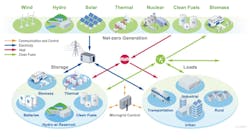Interest in Small Nuclear Reactors Is Increasing: What’s Their Role in Microgrids?
With climate change driving the need for more zero-carbon energy, interest is increasing in small, modular, nuclear reactors as a fuel source in microgrids. In fact, 80 reactor designs are currently under development, according to an International Atomic Energy Agency (IAEA) report.
The only operating small nuclear reactor is the Akademik Lomonosov floating power unit in Russia. Two-module KLT-40S reactors were connected to the grid in December 2019 and started commercial operation in May 2020, said the report.
Farthest along in the U.S. is the NuScale Power Module, which received standard design approval from the U.S. Nuclear Regulatory Commision (NRC) in September 2020. The NRC is expected to issue a final rule that certifies NuScale’s design for use in the U.S., the IAEA report said.
Modeling modular nuclear reactors with other energy sources
With so much interest and activity in small nuclear reactors, Idaho National Laboratory (INL) – along with software company Xendee – has developed an updated model that allows users to compare the economics of adding small nuclear reactors to microgrids along with other sources of energy, said Michael Stadler, Xendee’s chief technology officer and co-founder.
However, microgrid developers aren’t keen on the idea of adding nuclear reactors to their microgrids. Last year, Mike Byrnes, senior vice president of facilities and building services at Veolia North America, told Microgrid Knowledge that siting microgrids with nuclear reactors would be challenging. By definition, microgrids are located close to the load.
“Who’s going to want a nuclear reactor where they live?” he asked.
Modeling carbon dioxide reductions and system size
The model from Xendee and INL upgrades the Xendee platform so that it can demonstrate more sophisticated options, including small nuclear reactors paired with renewables in microgrids. The model provides information about carbon dioxide savings, the size of the technology needed to reap carbon savings and other data, said Stadler.
“In principle the model can consider costs for disposing nuclear waste, but those costs were not considered in the latest runs, which indicated that small reactors can be economically attractive,” Stadler said.
High disposal costs are expected to be a problem for small nuclear reactors.
Study says disposing of small reactor waste will be a challenge
A May 2022 study published in Proceedings of the National Academy of Sciences found that small nuclear reactors produce larger amounts of reactive waste than larger nuclear reactors.
In fact, the small modular reactors will increase the volume of nuclear waste that needs to be managed by factors of two to 30, the study found.
“This increase of volume and chemical complexity will be an additional burden on waste storage, packaging and geologic disposal,” said the study.
The large amounts of small nuclear reactor waste will need to be treated, conditioned and appropriately packaged before disposal. “These processes will introduce significant costs — and likely, radiation exposure and fissile material proliferation pathways — to the back end of the nuclear fuel cycle and entail no apparent benefit for long-term safety,” said the study.
The federal Department of Energy (DOE) is working to solve the disposal challenge. In March 2022, the DOE awarded $36 million for 11 projects that aim to limit the waste produced by advanced nuclear reactors, including small modular reactors.
Small nuclear reactors for remote microgrids that provide EV charging
Jim Reilly, a consultant to the federal DOE, said that small nuclear reactors are an important contributor to carbon-free resources and would be especially helpful under certain circumstances. Those circumstances include remote microgrids that supply power to electric vehicle (EV) charging stations sized 100 MW and larger, as well as college campuses that can take advantage of the heat generated by small nuclear reactors. In addition, the small nuclear reactors can be deployed on military bases and can also be used to replace coal plants, said Reilly.
In fact, a university in the Midwest wants to use the Xendee model to help decide how it can eliminate coal boilers and gas turbines by using renewables and small nuclear reactors, said Stadler.
“Reactor technologies are coming back; everyone is thinking about them,” Stadler said. Some companies in Asia and other countries have signed up for the Xendee platform to design systems that include small nuclear reactors. In a second university project – a partnership with a utility – the university wants to identify the ideal size of small nuclear reactors for its campus electricity system, Stadler said.
One model showed 92.8% drop in carbon emissions
Xendee used the platform to model a 500-kW small nuclear reactor plus 3.19 MWh of heat storage in a microgrid to meet the needs of an electricity load of about 800 kW, said Reynaldo Guerrero, principal engineer for Xendee. In addition, heat demand was about 900 kWh of thermal energy.
Without the reactors, heat was coming from natural gas boilers and electricity was purchased from the utility. The model showed that the small nuclear reactor-based microgrid could save 31.7% of energy costs, compared to utility power. In addition, carbon emissions would drop by about 92.8% compared to the utility, said Guerrero. Under this scenario, the microgrid would not island from the utility, and some electricity would be purchased from the utility.
The model did not include the cost of disposing of nuclear waste.
Why people are becoming comfortable with small nuclear reactors
Even though microgrid industry members have reservations about safety and nuclear waste disposal, some people are becoming more comfortable with small nuclear reactors, said Bikash Poudel, research engineer for INL.
“With advancements in safety measures, the concerns that people have had regarding nuclear safety are significantly reduced,” he said. People are more hesitant about traditional nuclear power plants because of their large size and high investment costs. The smaller sizes and lower investment costs associated with small nuclear reactors allow them to be adopted in microgrids and other smaller energy markets, attracting a broader range of investors, Poudel added. Investors are now more confident about investing in the technology because the Biden administration supports efforts to advance the technologies and expedite the licensing process, he said.
What’s more, small nuclear reactors are safer because they’re passively cooled and don’t need electric pumps for cooling circulation, Poudel explained
Large nuclear power plants need electricity for cooling and are at risk of a meltdown if there’s a station electricity blackout that eliminates cooling, he said. And small nuclear reactors can be designed for underground or underwater use, which reduces the chances of core meltdown, said Poudel.
In spite of the challenges of disposing of waste from small nuclear reactors, colleges, universities, foreign companies and others have expressed interest in deploying them – after first modeling them.
“Some people are just showing up on our doorstep to model their systems with small nuclear reactors,” said Stadler.









